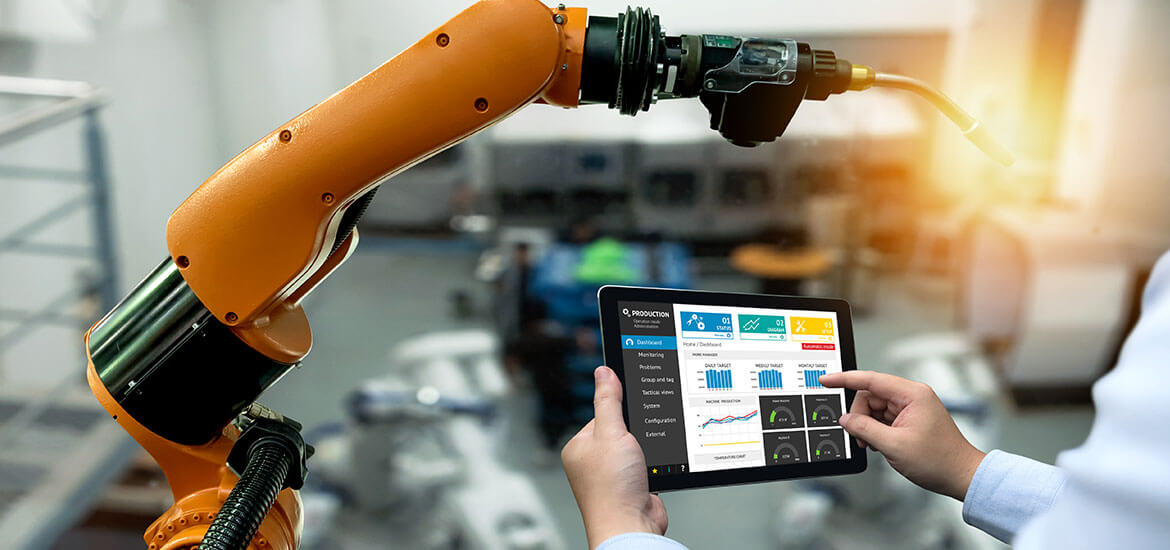
The use of technology in the manufacturing sector is not new. However, this sector is now gearing up for a world of convergence – one where digital and physical worlds converge to being transformative change with the Smart Factory. The Smart Factory takes the manufacturing sector from traditional automation to a completely connected, flexible ecosystem where data flows seamlessly from production and operation systems to unlock efficiencies, productivity, and better decision making.
The Smart Factory leverages technologies such as IoT, sensors, big data analytics, robotics, 3D printing (also called Additive Manufacturing), Artificial Intelligence, Augmented Reality and Virtual Reality amongst others. These technologies bring the excitement of high-profile benefits – predictive maintenance, lesser downtime, predictive analytics, productivity gains, less waste as well as better customer service. The benefits of this connected factory extend to better connectivity and improved information exchange even outside the factory walls extending to the supply chain. Clearly, this smart ecosystem extends across the length and breadth of the entire manufacturing touchpoints. Yes, it’s hard to not see the opportunities in the smart factory. The question is where do you begin?
India and the Smart Revolution
Indian manufacturing is now ripe for disruption. With social, economic and political winds favoring this segment, the time is ripe to leverage technology to propel manufacturing to new heights. However, considering the numerous touchpoints, it can be easy to feel out of depth. What should be the main considerations to start the smart journey? How do you get there? Is it an all or nothing proposition? The list of questions is extensive.
To evolve into a smart factory, manufacturers have to evaluate the smart initiative from a business perspective and not just a technology perspective. It is not about investing in the latest technology because it is the latest but because it provides a compelling and positive business impact. It isn’t about focusing on the latest software or hardware but, like MESA President Mike Yost says, “…there are some things you can’t change, like the way you build your product, whether it’s brewing beer or assembling a motorcycle…You can’t push smart technologies into plants without taking their perspective into account.”
This transition to a smart factory is a journey and here are the low hanging fruits to aim for.
Manufacturing Operations
Manufacturing organizations can take a look at their existing operations and evaluate opportunities for improvement and growth. Technologies such as cognitive robots or autonomous robots can be introduced gradually to conduct routine processes with complete accuracy. Additive Manufacturing or 3D printing can be used to produce rapid prototypes. Investments can be made into better data analytics to allow the use of real-time inventory and production data for better scheduling and planning.
Warehouse Operations
I think all manufacturers would unanimously agree that predictive maintenance has been a boon for them so far. In the Indian manufacturing ecosystem, using technology to make the analytics even more intelligent by using real-time data generated from sensors will drive the production process northwards.
AR or Augmented reality also finds a compelling place in the maintenance ecosystem. AR can make the maintenance and repair operations easier by allowing real-time step-by-step, highly-visual, and efficient self-service.
Product Innovation and Quality
Quality testing lends itself for betterment with optical-based analytics. Along with this, with real-time monitoring capabilities, it becomes easier to predict quality issues. Additive Manufacturing opens up doors for innovation by enabling rapid prototyping faster.
Health and Safety
Manufacturers have to pay close attention to the health and safety, both of the environment and the employees. In this age, we must become more environmentally conscious and ensure we take measures to optimize our energy consumption, reduce waste, and reduce our carbon footprint. Sensor technology can be employed here to monitor lack of activity and movement and environmental conditions for optimized energy consumption. Sensors can also be used to ensure dangerous equipment is geofenced for the security of personnel. These sensors can also be employed to monitor other potential threats that can impact the health and safety of the workers on the shop floor.
In Conclusion
The Smart Factory is more of an evolution than a revolution in manufacturing. Given that India is a technology hub, has a large internet and smartphone user base, and has a talent pool of engineers leaning towards technology, embracing the Smart Factory is not hard. Indian manufacturers can start small in this journey and leverage game changers like mobile apps and AR, to begin with.
Gradual progression is the name of the game here. Jonathan Van Wyck, partner and managing director at BCG succinctly sums up the approach that the Indian Manufacturing sector could benefit from. He says, “Industry 4.0 should not start with technologies; it’s about understanding your operations, pain points, opportunities and biggest cost buckets, and then working from the pain points to apply technologies to design a solution.”
So where do you stand on your smart journey?
